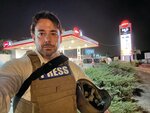





ASHKELON, Israel — Driving south from Jerusalem toward the border of the Gaza Strip, I wondered how long it would be before the Red Alert app that I had downloaded to my phone on my arrival in Israel would indicate a rocket strike was imminent.
After arriving in Ashkelon, about six miles from the Erez Crossing into Gaza, it would take only 45 minutes.
I parked in the sandy lot of a seaside hotel; one being used by many foreign journalists covering the war. After seeing several news crews walking out wearing their body armor a little too proudly, I decided to leave mine in the trunk of the rental while I walked out to Dlilah beach. From my vantage point, I could see what appeared to be an Israeli Defense Forces Dvora Class fast patrol boat offshore in the Mediterranean, and a black Zodiac Combat Rubber Raiding Craft carrying a cadre of commandos speeding by much closer to shore.
I took note of how isolated the beach was on an otherwise beautiful, 85-degree day, save for a group of four, French-speaking men playing paddle ball near the closed canteen area, whom I took for a foreign TV news crew enjoying some downtime. I also spotted a man sporting a red swimsuit who reminded me of David Hasselhoff, and most peculiar of all, a bikini-clad woman lying face down in the sand about 200 feet away reading a book.
I looked up, seeing a helicopter gunship overhead and a large unmanned aerial combat vehicle circling between the beach and the Gaza border.
It was then that it happened.
The air raid siren roared to life and in the same instant, the Red Alert app chimed a warning. I looked down, seeing it read “Ashkelon Southern Industrial Zone.”
“That’s where I am,” I started to say as the loud report of an Iron Dome battery hidden nearby discharged five rockets in a whoosh into the sky. Within seconds explosions could be heard as smoke billowed from where they had intercepted their targets. I thought one of the rockets launched by Hamas had evaded the defenses when the Iron Dome missile performed a loop and neutralized it. It was a stunning sight to behold.
That evening, I made sure to wear the body armor as I drove along a lonely, dusty back road under an eerie purple sky, to a point about five miles north of the border, past which only military vehicles were allowed to continue south on Day 1 of the IDF’s land incursion into Gaza.
From there I would see many Hamas rocket launches, with most heading high and to the north, with the Red Alert app chiming out warnings incessantly for the Tel Aviv and Central Israel areas.
I would experience yet another attack before the night was out. I arrived back at my hotel around 10 p.m. and was unpacking my gear when the siren blared. I pulled back the curtain to see the red fire trails of two rockets that had just lifted off from Gaza and were headed my way. Then, I was stunned to see an Iron Dome interceptor streak past, threading the needle between my hotel and an apartment building about 500 feet away.
At the same time, there was a hotel alert in Hebrew for guests to head to the nearest bomb shelter, with one located on each floor. I heard doors opening and slamming and people running in the hall. Although the shelter on my floor was conveniently next door to my room, I reached for my camera gear and ran to the balcony. My decision to witness and capture such events instead of sheltering from them, unless it was a barrage of rockets with some destined to slip through Iron Dome, was governed by two guiding principles. First, I didn’t travel 6,000 miles to a war zone to hide in a shelter. The second was more in the form of a question: “What are the odds, really?” I took solace in that and the fact that I could still have the sense of humor I needed to counterbalance the gravity of the situation that brought me there in the first place.
While in Ashkelon, a city of 150,000, which was inhabited by the Philistines beginning around 1,200 B.C., I spoke with several residents, asking them how they have endured living like this for years, under constant threat of attack. Qassam and Grad rockets have been a constant source of anxiety as they have long been used to terrorize.
At the Giron Mall, the stores are all but closed due to the complete drop off in tourism and locals not wanting to go as much with the intensity of the fighting, which can be heard plainly, with the machine gun staccato fire and non-stop explosions being heard day and night, even six miles from the front line.
Galit, a clerk at the Super-Pharm Pharmacy, one of the few stores that still open for business each day, showed me a video taken by her husband of the aftermath of a Qassam rocket attack on their apartment complex. I immediately recognized the images as those I had seen on television from the first day of the war, when a rocket landed in a parking lot and set several cars ablaze.
I asked her what she thought would be the best course of action to ensure her peace and safety going forward. She said she had lived like this for 20 years, but after the extreme brutality of the attacks carried out on Oct. 7, there was no way that Israelis and Palestinians could live in such proximity again.
“They need to flatten it,” she replied with a scowl on her face as she made lateral motion with her hand implying the IDF should raise everything in the Gaza Strip to the ground, following the horrific attacks on kibbutzim beginning only a couple of miles away from there and extending into the desert interior.
It was there that I had visited Kibbutz Nirim last December as part of an international journalist group invited to the Christian Media Summit sponsored by the Israeli Government Press Office. It was there that I met several residents and was taken right to the border fence, where we could see Khan Younis, Gaza’s second-largest city, from only three miles away. Next door was Kibbutz Nir Oz, which sustained the loss of about one-quarter of its population in the terror attacks. I would later speak with a mother from that adjoining kibbutz as she grieved over her two children and their father who were kidnapped and are being held hostage in Gaza, with her mother and niece taken the same day.
I would see the very poignant display of large teddy bears circling the fountain in Tel Aviv’s Dizengoff Square, the center of the city where people have come from around the world to visit memorials to the 1,200 people killed at the hands of the terrorists and to pray for the safe return of the 200 people, including 30 children still being held hostage.
In Jerusalem, I sat down for interviews with the Latin Patriarch, Cardinal Pierbattista Pizzaballa, and Joseph Hazboun, regional director of the Catholic Near East Welfare Association. I also visited the West Bank to see how the everyday relationship between Israelis and Palestinians has changed since Oct. 7.
One of the most endearing things I covered was a dinner, sponsored by both a Jewish and a Christian organization, along with a local business owner, to make life a little brighter for a number of families who have had to leave their homes on the border for their safety for a while and were put up in a Jerusalem hotel for a couple of weeks, until they could make other arrangements.
The series will continue with these stories being featured in upcoming editions of Rhode Island Catholic.